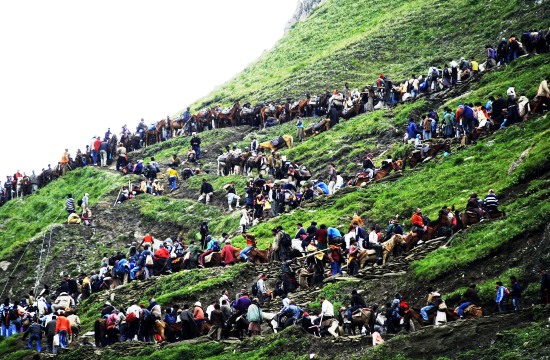Lakhs of tourists are visiting Kashmir besides the half a million Amarnath pilgrims. However, the unregulated and badly managed affair is putting valley’s fragile environment at risk. HUSSAIN DANISH reports.

With Amarnath pilgrimage set to commence from June 29, the state has declared its preparedness to host the pilgrims from across the country. But environmental experts are not so sure whether the fragile environment of Kashmir is also ready to host over six lakh pilgrims expected this year.
One of the largest glaciers of Kashmir Himalayas, Kolahai, has been melting at a concerning rate, a study by geology and geophysics department of University of Kashmir has revealed.
The Government of India sponsored research project has revealed 18 per cent shrinkage in the glacier in past three decades. The glaciated area of Kolhai, study reveals, has undergone drastic changes in the recent past. The glacier area has shrunk from 13.87 sq km in 1976 to 11.24 sq km in 2006. In 1999, it was spread over an area of 12.98 sq km and shrunk to 1179 sq. km in 2001, it reveals.
The glacier has developed several crevasses and cracks over the years. “In past 30 years we have lost 18 per cent of the glacier and it is still melting,” says Dr. Shakil A Romshoo of Department of Geology and Geophysics who is heading the study.
The main reasons for glacier’s melting, according to Romshoo, are climate change and drop in the precipitation. But the impact of human interference cannot be ignored, he says.
“See we need to determine the carrying capacity of our environment. Then we need to see how much human rush can be accommodated,” he says. “Go to Pahalgam on a Sunday and you will not find an inch of a space free anywhere. It is putting excessive burden on our environment.”
“Today every MLA wants developmental authority in his/her constituency, but government needs to have a policy for regulation of tourism,” he opines. According to Ramshoo, the melting of glaciers is leading to water scarcity in Kashmir. The river Jhelum, he says, has 24 sub-basins and 18 of them are showing decline in water.
“That is why we are facing water scarcity in summers,” he says. “There has to be action at the national level. But things like regulation of tourism can be done locally.”
The three year study that Ramshoo is heading is going to submit a list of recommendations to the Union Ministry of Environment. “It will include the need for regulation of tourism, yatra included,” says Romshoo.
“If we see in summer months, the load in Lidder Valley is beyond its capacity. And irrespective of who the visitors are, the rush needs to be regulated because it is having adverse effects on the environment,” explains Romshoo.
The other glaciers of Kashmir are also heading in the similar direction.
The Suroo basin in Kargil, says Ramshoo, has 368 glaciers of which five have vanished in past 50 years while many are showing enhanced melting.
“It is due to overall change in the climate caused by various factors. We are seeing increase in minimum and maximum temperature almost every season now. The precipitation in the winters has come down drastically. There was almost no snow in the last winter,” he says.
Romshoo in one of his articles published in a local daily has said that the preliminary results from the research carried out in UK suggested: “Depending upon the level of future emissions, the average temperature increase in valley, by end of the 21st century, may be between 2 and 3 degree Centigrade. Glaciers are receding at a faster rate in the state compared to other glacial regions in the world. In Suru basin alone, we have lost about 16% of glaciers for the last 40 years.”
“Climate change is likely to affect a number of sectors, particularly irrigated agriculture, horticulture, and hydropower capacity in the state. Changes in flow magnitudes are likely to raise-















